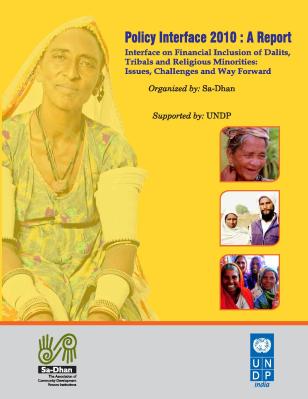Policy Interface 2010 - A Report Interface on Financial Inclusion of Dalits, Tribals and Religious Minorities : Issues, Challenges and Way Forward

Policy Interface 2010 - A Report Interface on Financial Inclusion of Dalits, Tribals and Religious Minorities : Issues, Challenges and Way Forward
February 20, 2013
With the aim to understand, promote and highlight the importance of financial inclusion of Scheduled castes, Scheduled tribes and religious minorities, Sa-Dhan in collaboration with UNDP conducted an interface between government representatives, academicians, journalists, practitioners and other stakeholders.
It was a practice in medieval times for Dalits to tie an earthen pot around their necks so they could spit in the pot and not defile higher castes. This principle of purity and pollution has, for centuries, legitimized exclusion – socially, culturally, politically and economically – and exacerbated atrocities.
The word ‘Dalit’ means broken and downtrodden in Sanskrit. Popularized by B.R. Ambedkar in the 1920s and 30s, the term gave a new secular identity to millions of those formerly known as ‘untouchables’ in India. After India gained independence in 1947, Dalits and other marginalized groups have tried often with the help of government programs to participate in mainstream development processes. However, a large population still remains excluded.
Cas te-based exc lus ion and di s c r iminat ion are es sent ial ly “ s t ruc tural in nature” and comprehensive and multiple in coverage, involving as their very basis the denial of equal opportunities. The practice of caste-based exclusion and discrimination is defined as “livingmode exclusion” or exclusion from political participation, alongside exclusion from and disadvantages in accessing social and economic opportunities.
Although plenty of work has already highlighted the processes of marginalization of Dalits and other minorities there remains a need to both further this understanding and use it to establish more systems to halt and indeed reverse the process of exclusion.
It is indisputably true that economic deprivation creates the basic condition for all other forms of exclusion. Indeed, financial inclusion is the key to social and political inclusion. It is imperative to address the immediate financial needs of Dalits and other marginalized communities in order for them to focus on other structural changes and to enable changes in the mindset of the dominant community and polity.
It is also accepted that microfinance creates access to productive capital along with human capital (education, training, nutritional status, etc) and social capital (through local organizationbuilding, women’s empowerment, etc), and enables the marginalized poor to escape poverty. Further, the credit and services of microfinance not only uplift the poor from income povertybut also from knowledge poverty. Further efforts in this direction are impossible without inter-disciplinary understanding and interdepartmental cooperation and coordination

 Locations
Locations